
The Socialist Party of Indonesia was a political party in Indonesia from 1948 until 1960, when it was banned by President Sukarno.
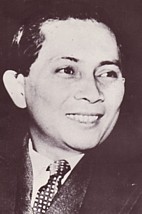
The position of Prime Minister of Indonesia existed from 1945 until 1966. During this period, the prime minister was in charge of the Cabinet of Indonesia, one of the three branches of government along with the People's Representative Council and the president. Following his 1959 decree, President Sukarno assumed the role and powers of prime minister until his resignation in 1966.
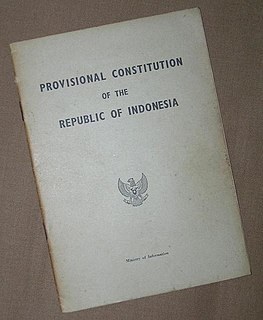
The Provisional Constitution of 1950 replaced the Federal Constitution of 1949 when Indonesia unilaterally withdrew from the union with the Netherlands agreed at the Round Table Conference and returned to being a unitary state. It came into force on 17 August 1950. It was abrogated on 5 July 1959 when President Sukarno issued a decree dissolving the Constitutional Assembly and restoring the 1945 Constitution of Indonesia.

Muhammad Hatta Rajasa is an Indonesian politician who served as the Coordinating Minister for the Economy of Indonesia from 22 October 2009 to 13 May 2014. A member of the National Mandate Party (PAN), he previously served as Minister Secretary of State (2007-2009), Minister of Transportation (2004-2007), and Minister of State for Research and Technology. He was also general Prabowo Subianto's running mate in the 2014 Indonesian presidential election, with the ticket being backed by a number of parties, including the Gerindra party, National Mandate Party, Prosperous Justice Party, United Development Party, the Crescent Star Party and Golkar.
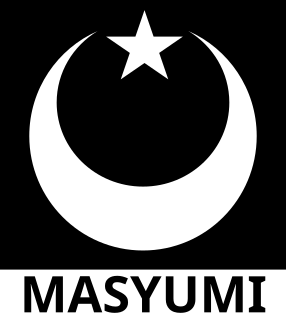
The Masyumi Party was a major Islamic political party in Indonesia during the Liberal Democracy Era in Indonesia. It was banned in 1960 by President Sukarno for supporting the PRRI rebellion.
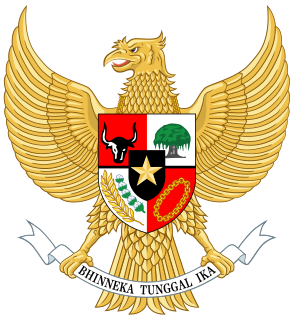
The Cabinet of the Republic of Indonesia is part of the executive branch of the Indonesian government. It is composed of the most senior appointed officers of the executive branch of the government serving under the president. Members of the Cabinet serve at the pleasure of the president, who can dismiss them at will for no cause.
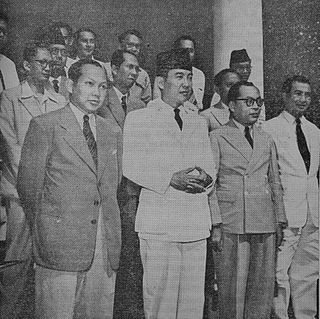
The Republic of the United States of Indonesia Cabinet was established as a result of the formation of the United States of Indonesia following the transfer of sovereignty from the Dutch colonial power. It lasted less than a year before Indonesia became a unitary state.

The first Sjahrir Cabinet was the second Indonesian cabinet, named after the Prime Minister. It served from November 1945 to February 1946.

The second Sjahrir Cabinet was the third Indonesian cabinet and the second formed by Sutan Sjahrir. It served from March to June 1946.

The third Sjahrir Cabinet was the fourth Indonesian cabinet. It served from October 1946 to June 1947, when it fell due to disagreements related to implementation of the Linggadjati Agreement and subsequent negotiations with the Dutch.

The second Amir Sjarifuddin Cabinet was Indonesia's sixth cabinet and was the result of a reshuffle to allow for the entry of the Masyumi Party, which gained five posts. The cabinet lasted only two months and eleven days, from 12 November 1947 to 23 January 1948, after Masyumi withdrew its ministers in protest at the Renville Agreement the government signed with the Dutch.

Sjafruddin Prawiranegara's Emergency Cabinet was the government of the Emergency Government of the Republic of Indonesia (PDRI), effectively Indonesia's government-in-exile, established in Bukittinggi, West Sumatra following the second Dutch military aggression when the republican capital of Yogyakarta was seized and most of the cabinet allowed itself to be captured in the hope of attracting sympathy from the outside world.
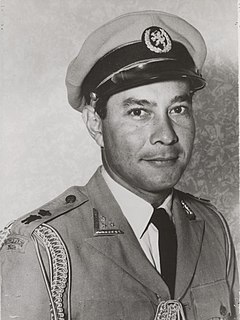
Sultan Hamid II was the eighth Sultan of Pontianak and the only President of the State of West Kalimantan from 1946 to its disestablishment in 1950. He was the eldest son of Sultan Syarif Muhammad Alkadrie. He was of mixed Malay-Arab ancestry and was raised by two British nationals— Salome Catherine Fox and Edith Maud Curteis.

The Federal Consultative Assembly, (BFO) was a committee established on 8 July 1948 to discuss the form of the planned federal United States of Indonesia. Its membership comprised the leaders of the various federal states established by the Dutch in the areas they occupied following their attack on the areas of Indonesia controlled by republican forces during the Indonesian National Revolution (1945–1949). It took part in negotiations with the Dutch in August and September 1948, and participated in the Dutch–Indonesian Round Table Conference at which the Dutch agreed to hand over sovereignty to the United States of Indonesia.
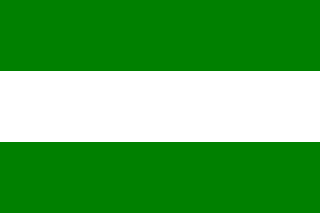
The State of Pasundan was a federal state (negara bagian) formed in the western part of the Indonesian island of Java by the Netherlands in 1948 following the Linggadjati Agreement. It was similar to the geographical area now encompassed by the current provinces of West Java, Banten and Jakarta.

The United States of Indonesia, was a short-lived federal state to which the Netherlands formally transferred sovereignty of the Dutch East Indies on 27 December 1949 following the Dutch-Indonesian Round Table Conference. This transfer ended the four-year conflict between Indonesian nationalists and the Netherlands for control of Indonesia. It lasted less than a year, before being replaced by the unitary Republic of Indonesia.

The Republic of Indonesia was a federal state (negara bagian) of the United States of Indonesia (RUSI) which was established on 27 December 1949. The territory of the state included parts of Java and most of Sumatra, and its capital was Yogyakarta. The acting president of the Republic was Assaat and the prime minister was first Susanto Tirtoprodjo until 16 January 1950, then Abdul Halim. On 17 August, the United States of Indonesia ceased to exist as the last of the component states dissolved themselves into a unitary Republic of Indonesia encompassing the entire territory of the former Dutch East Indies except for West Papua.
The Cabinet of the State of East Indonesia served as the central government apparatus of the State of East Indonesia, headed by a prime minister who were appointed by the head of state. During the three-year lifetime of the state between 24 December 1946 and 27 December 1949, there were eight cabinets in total, headed by six different prime ministers.

The Prime Minister of Pasundan was the head of government and the highest political office in the short-lived State of Pasundan (1948-1950). Appointed by the Wali Negara of Pasundan from among influential Members of Parliament, the Prime Minister was responsible to the Parliament, and his cabinet could be dismissed by a vote of no confidence.















